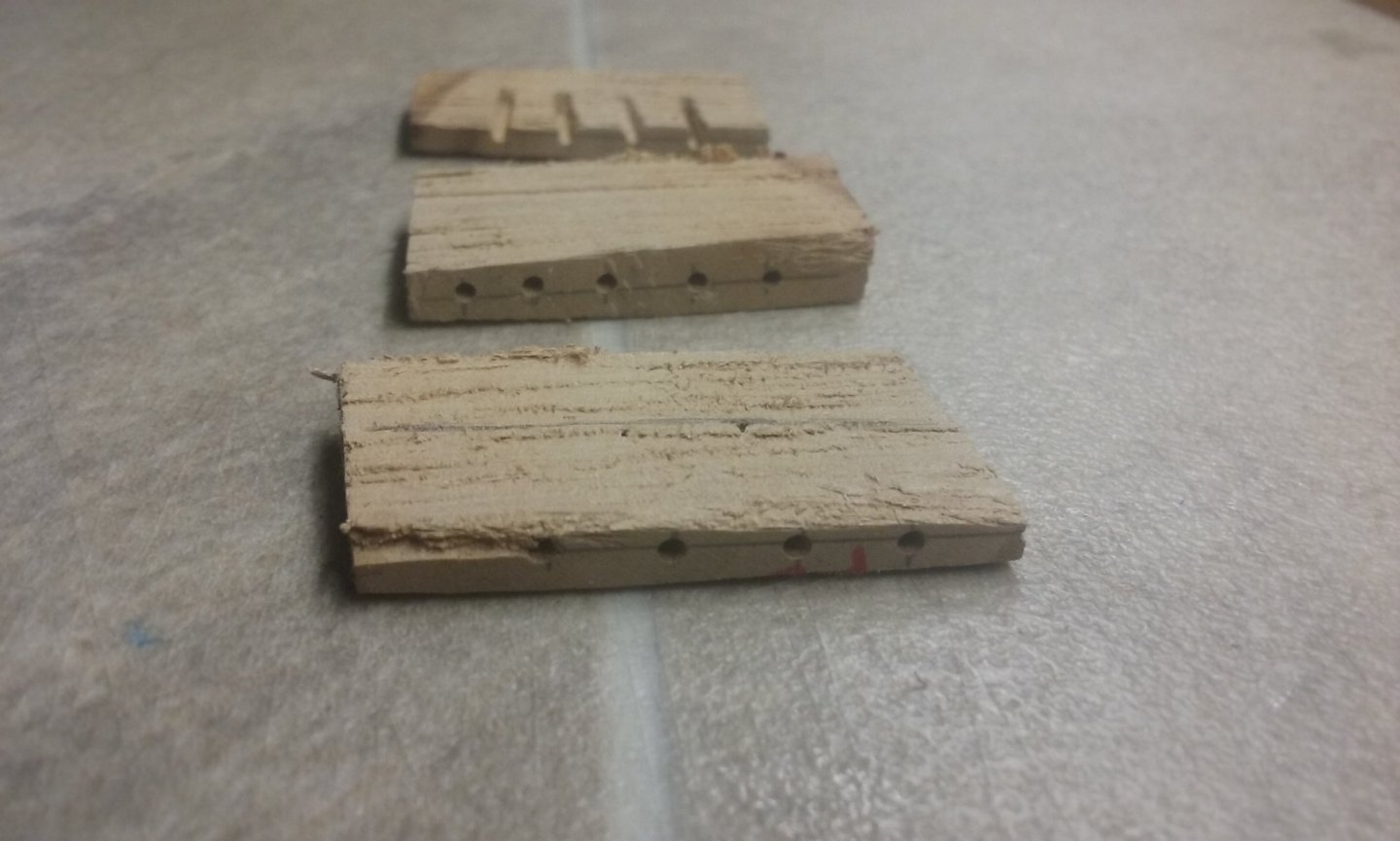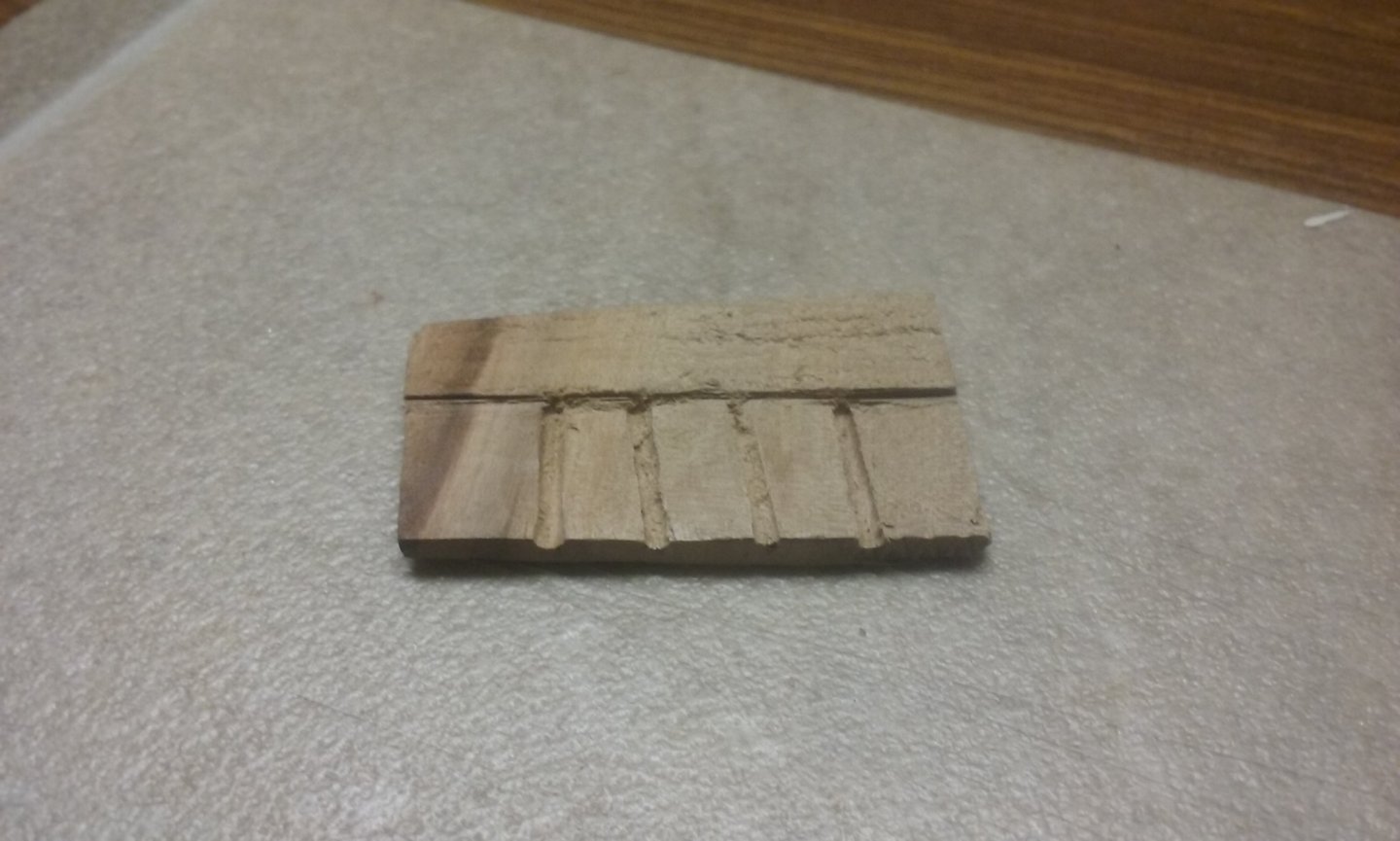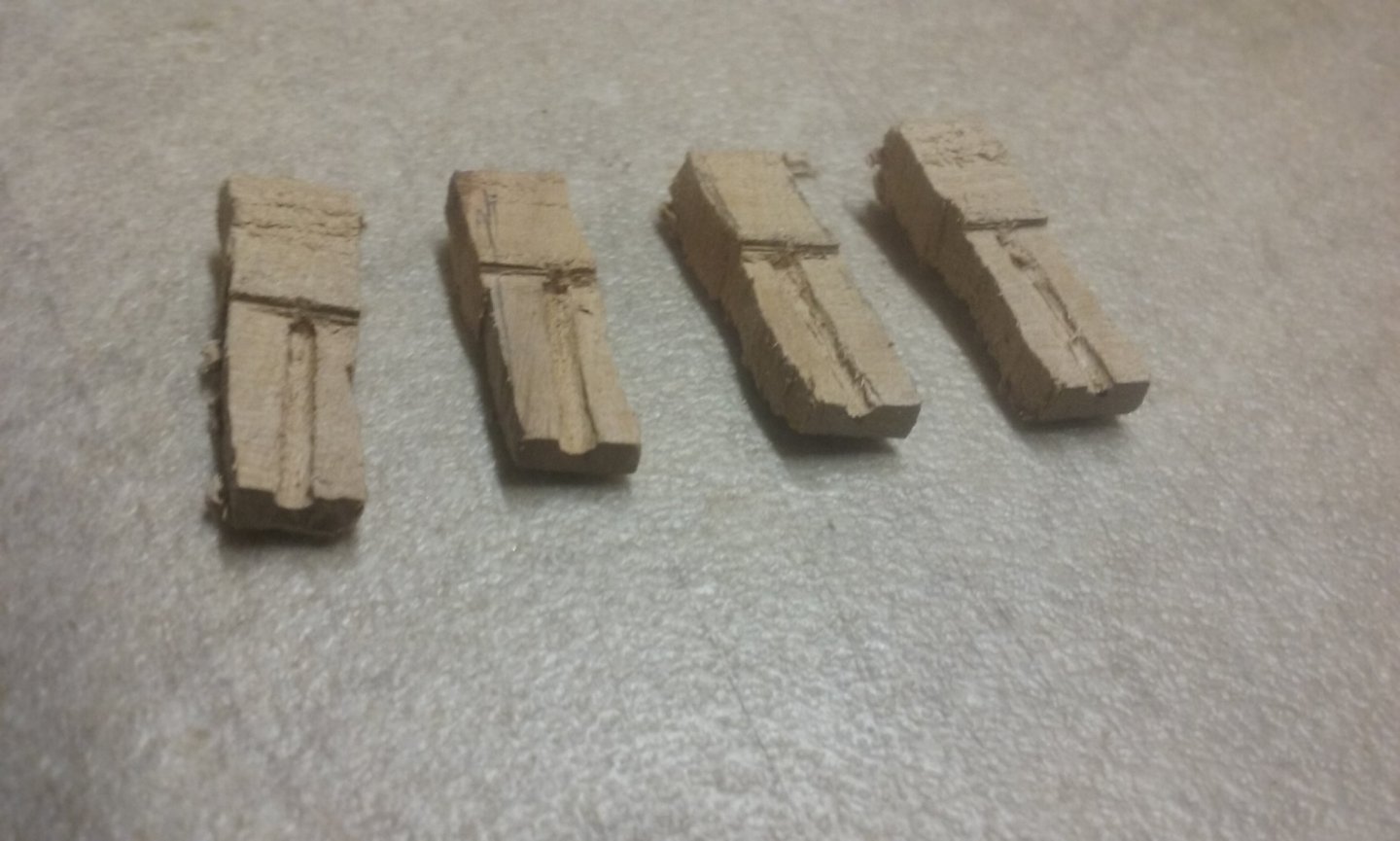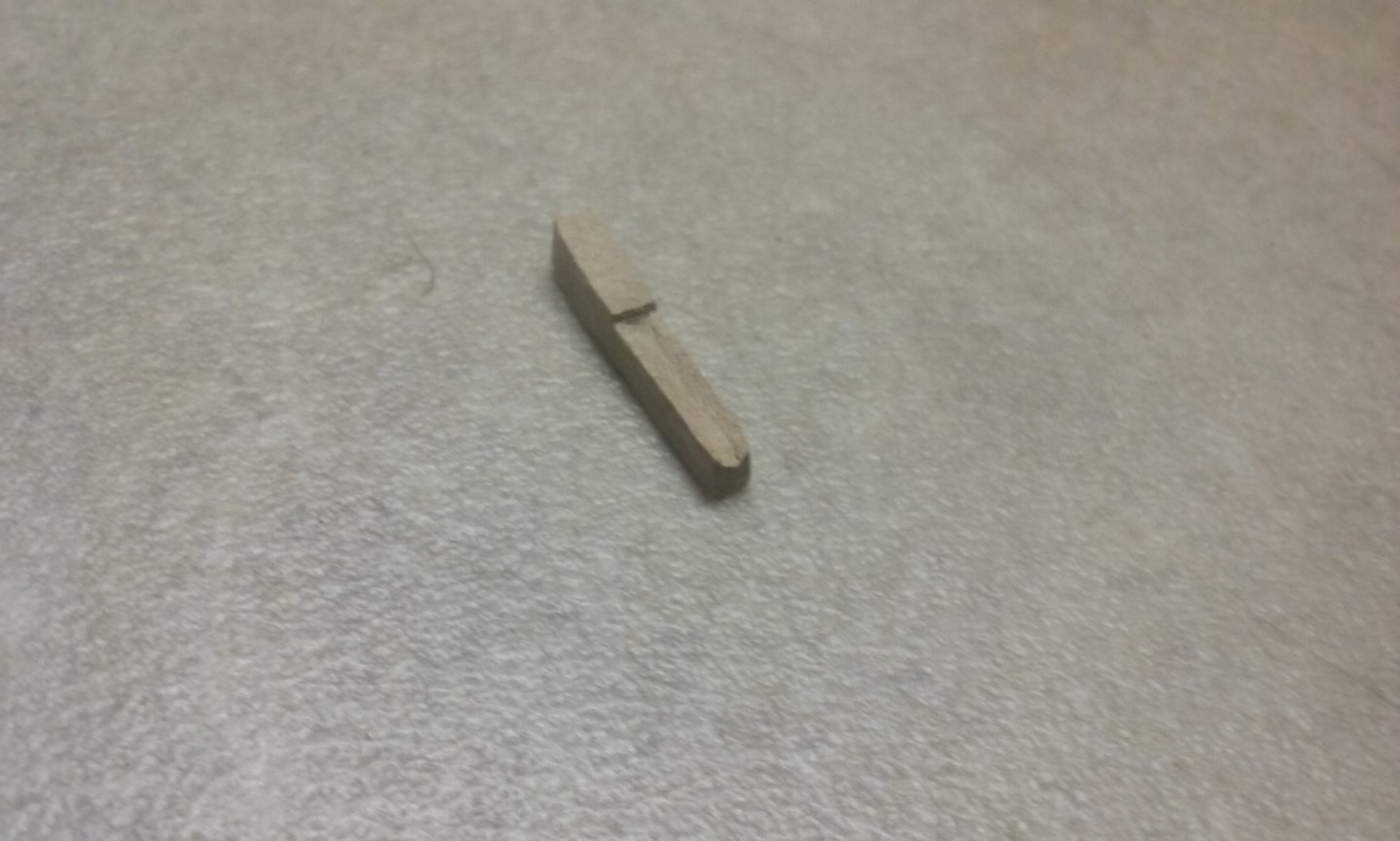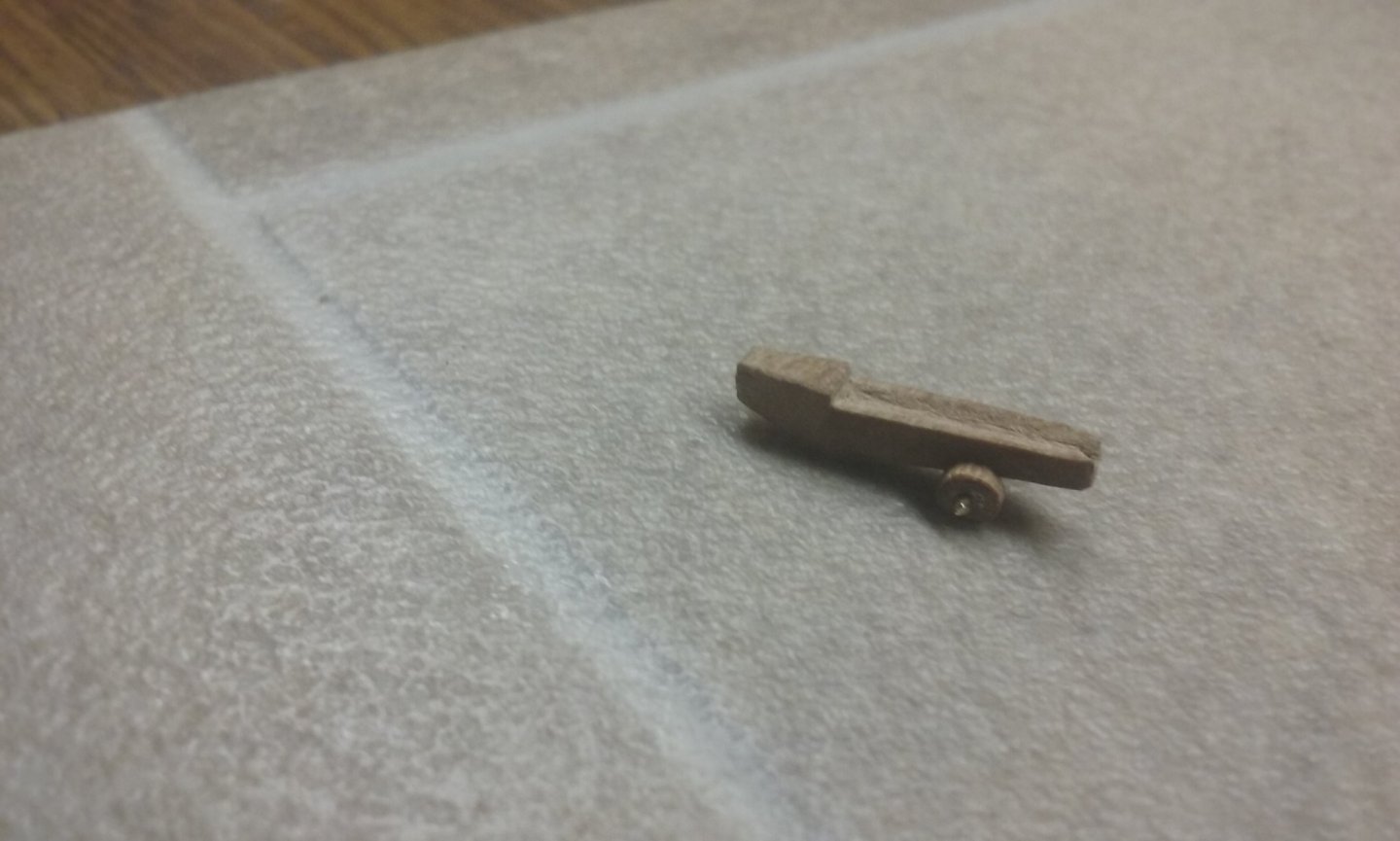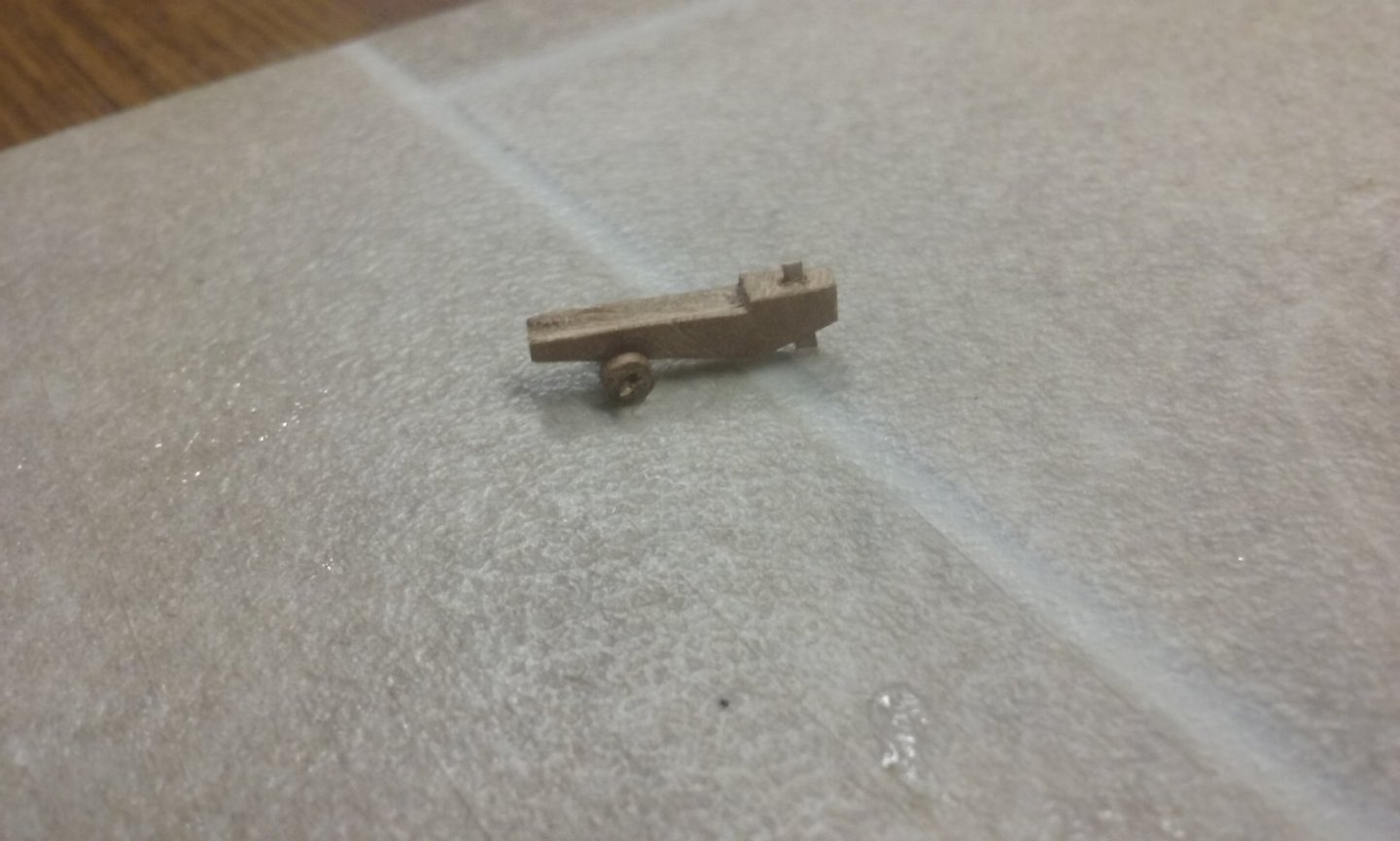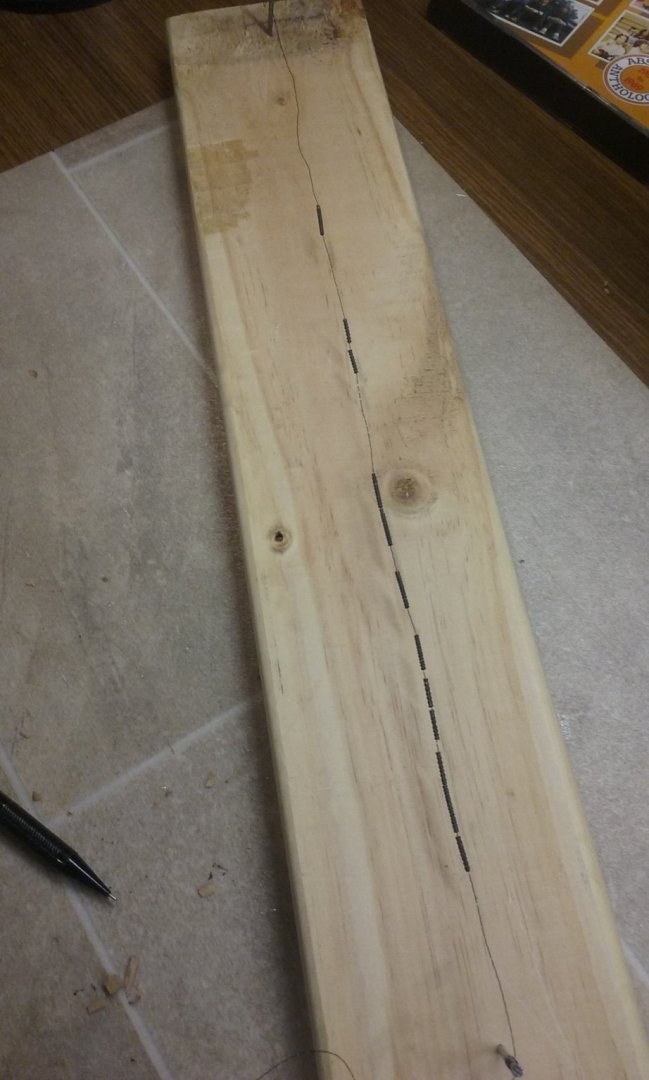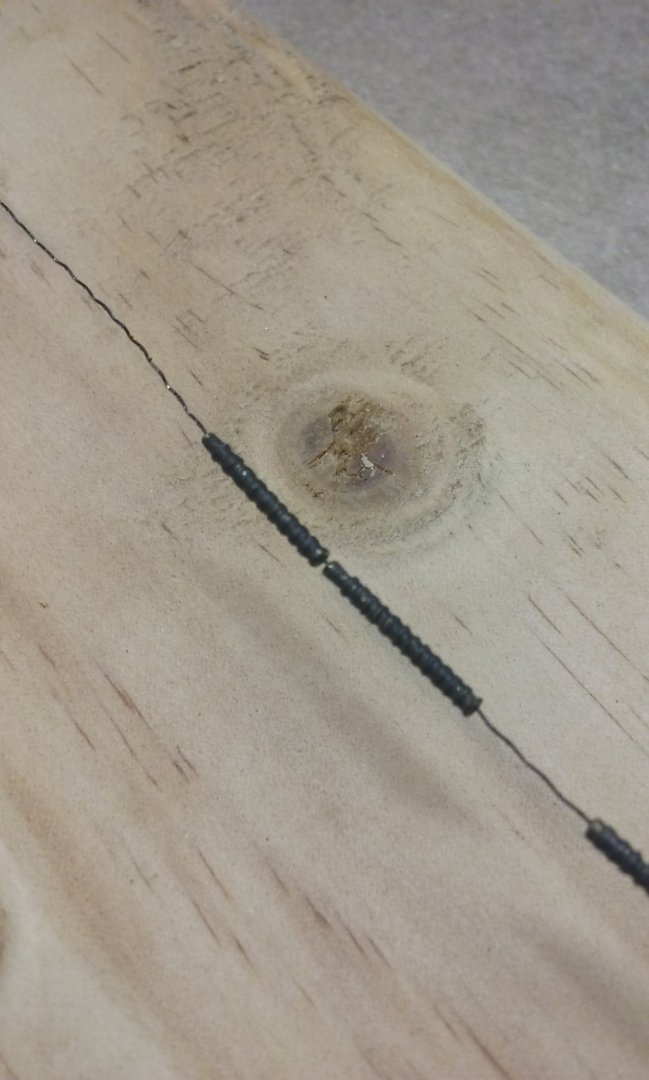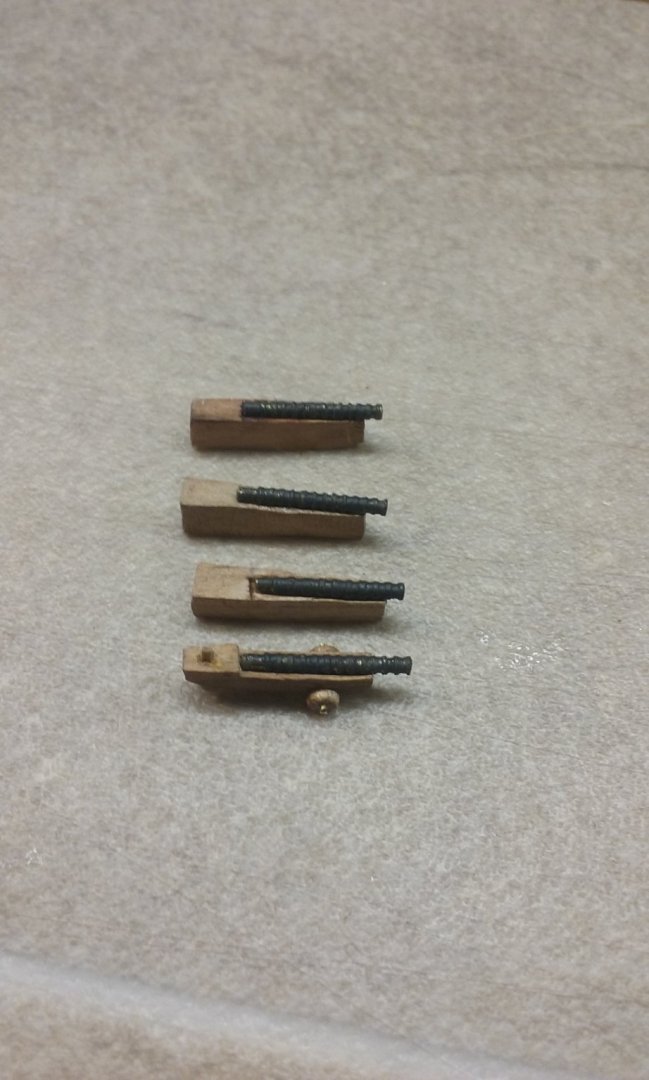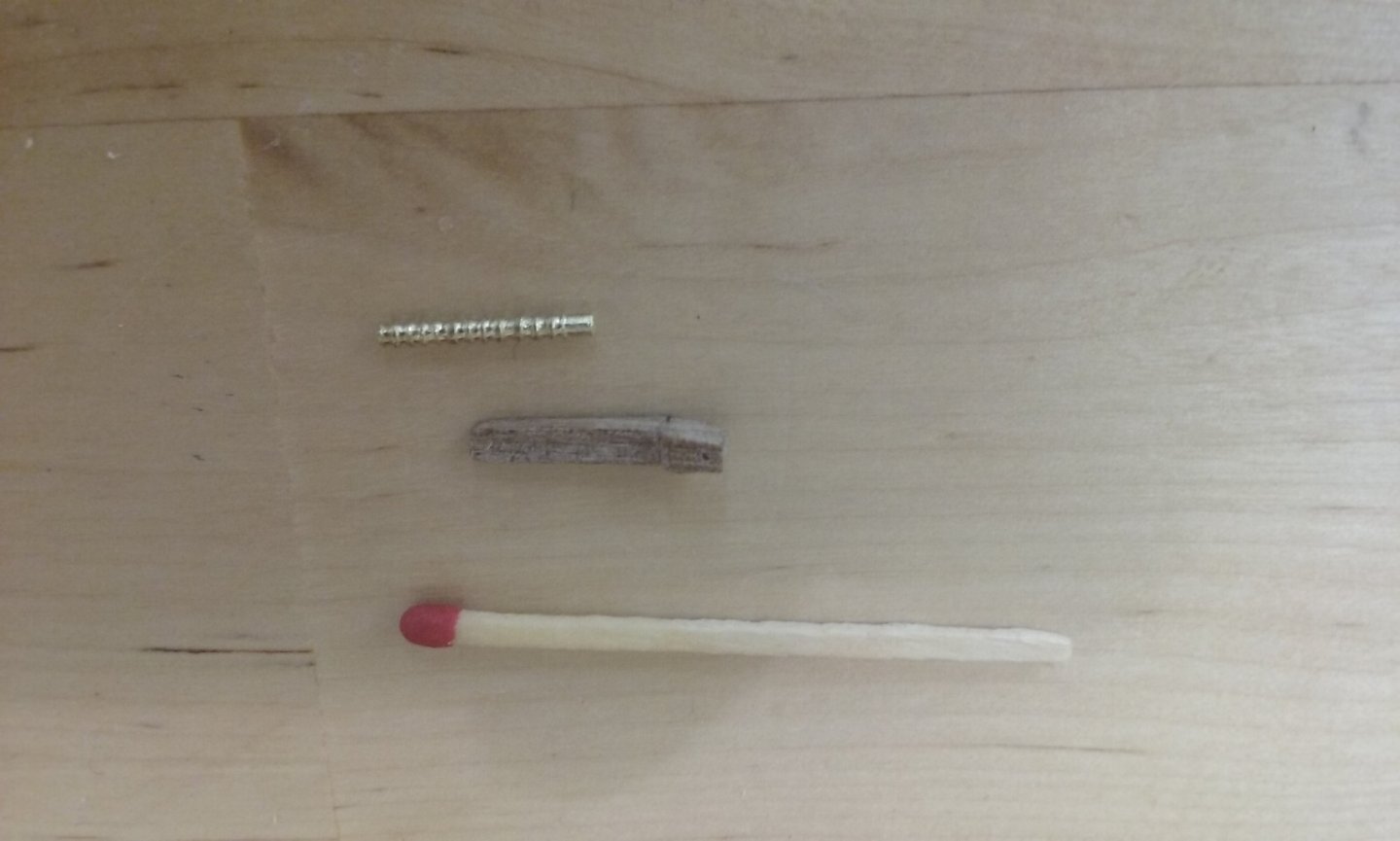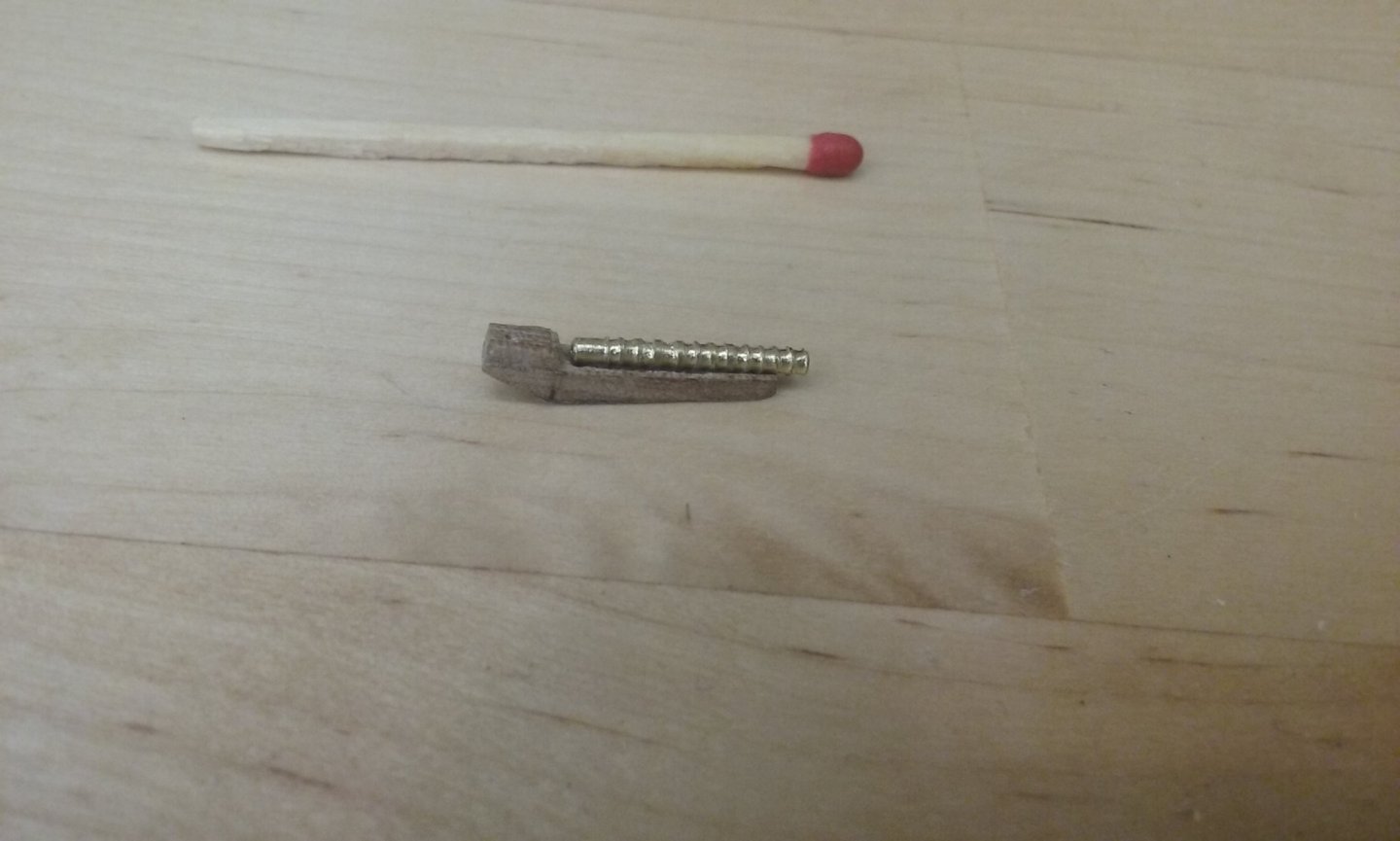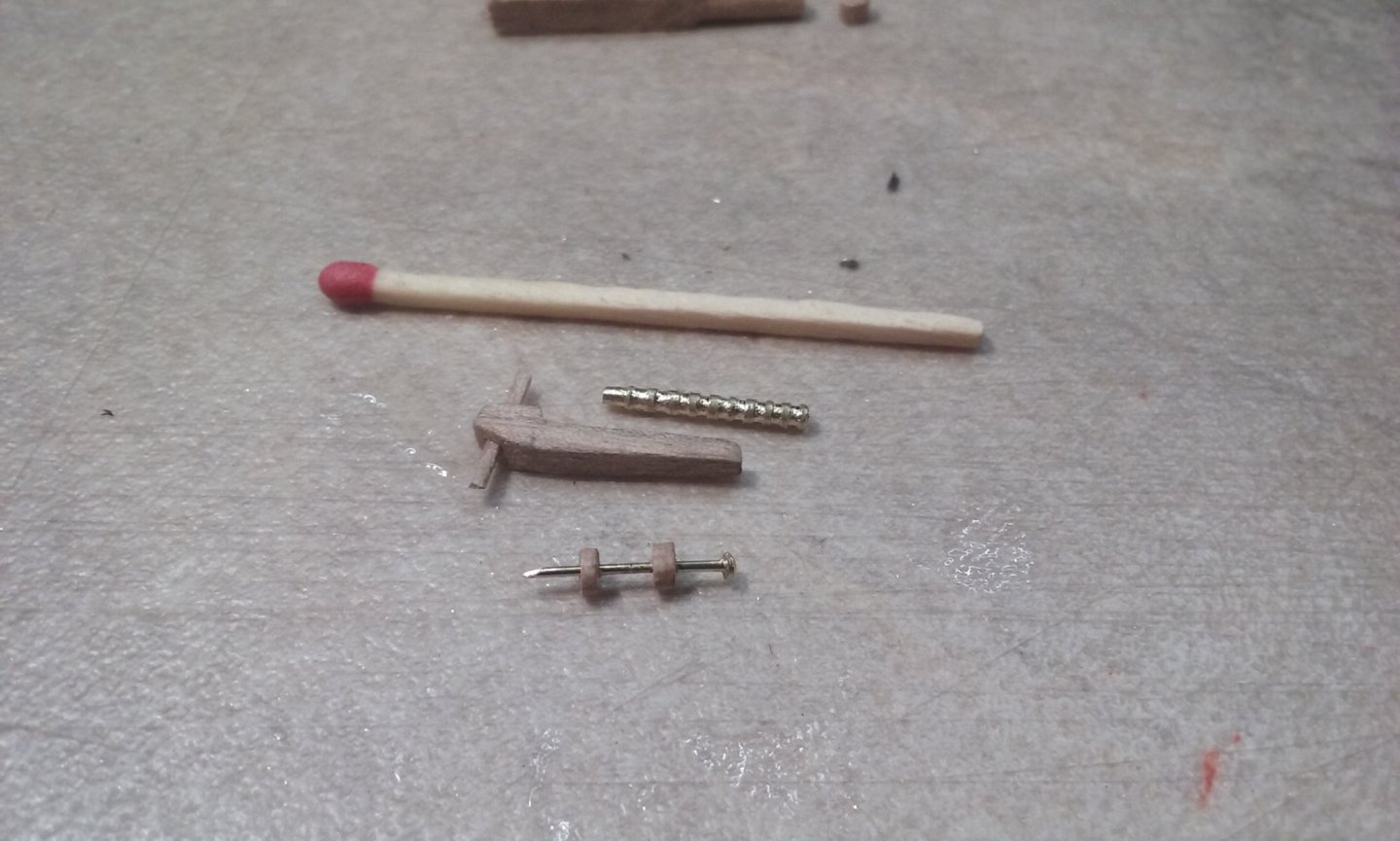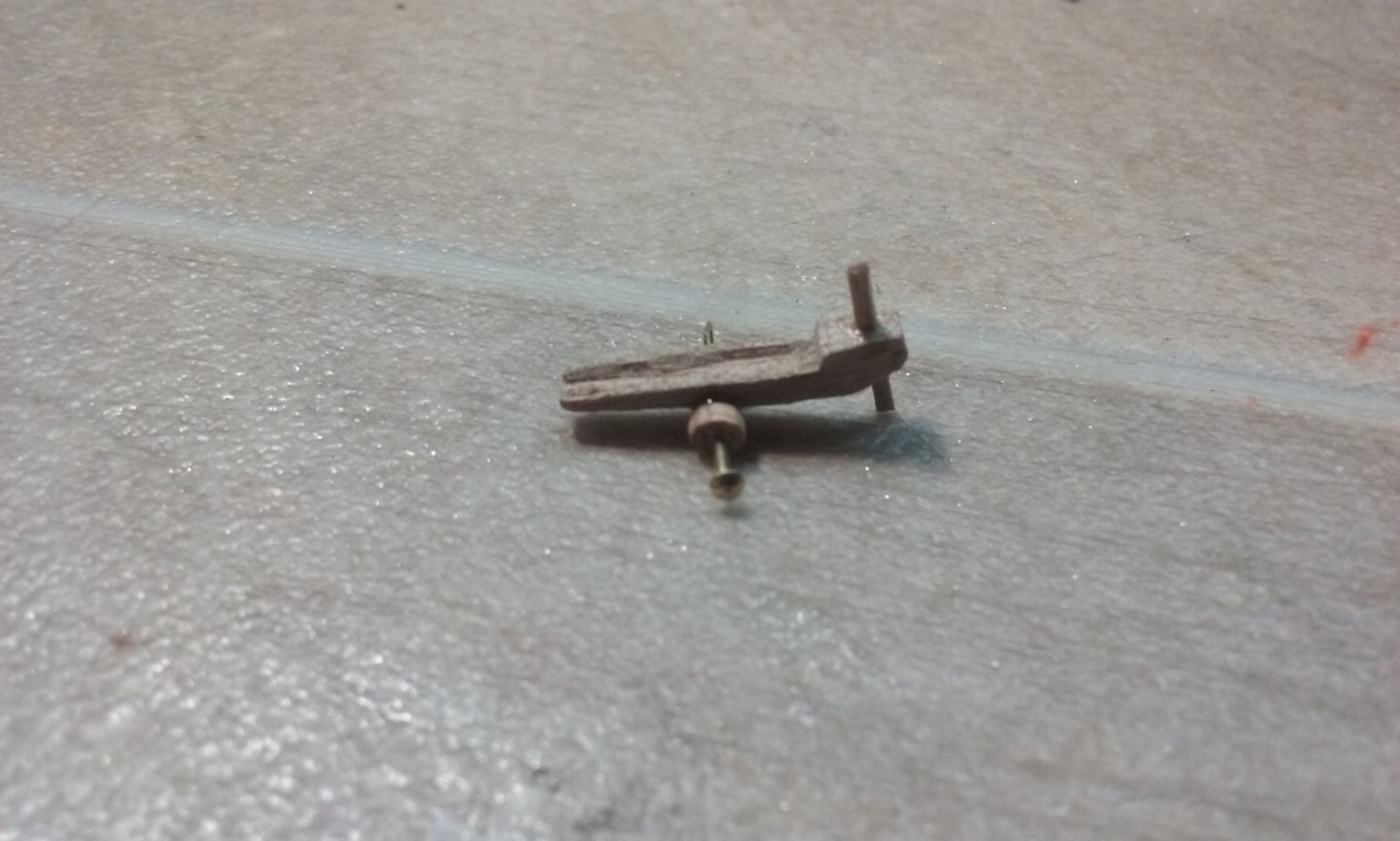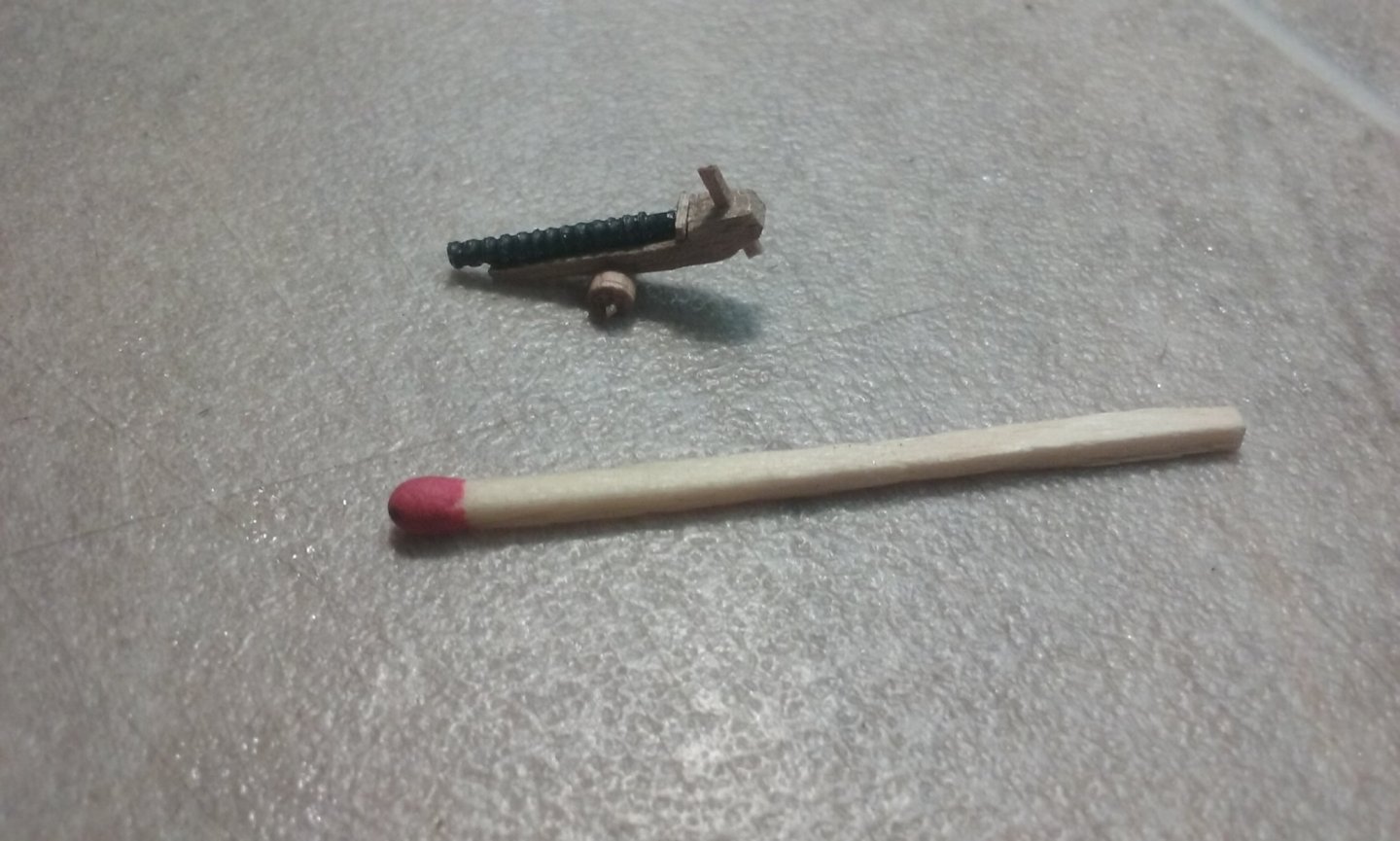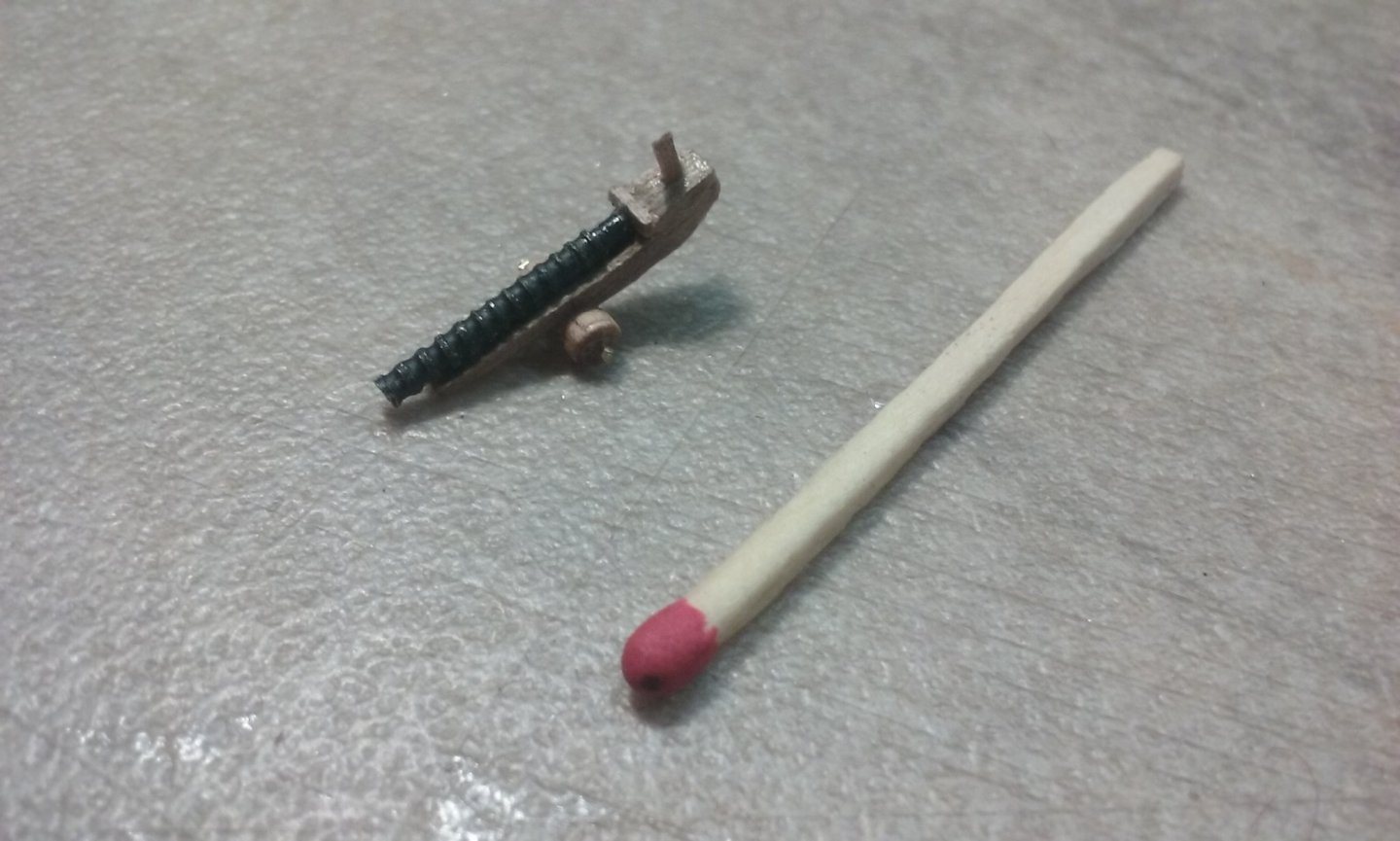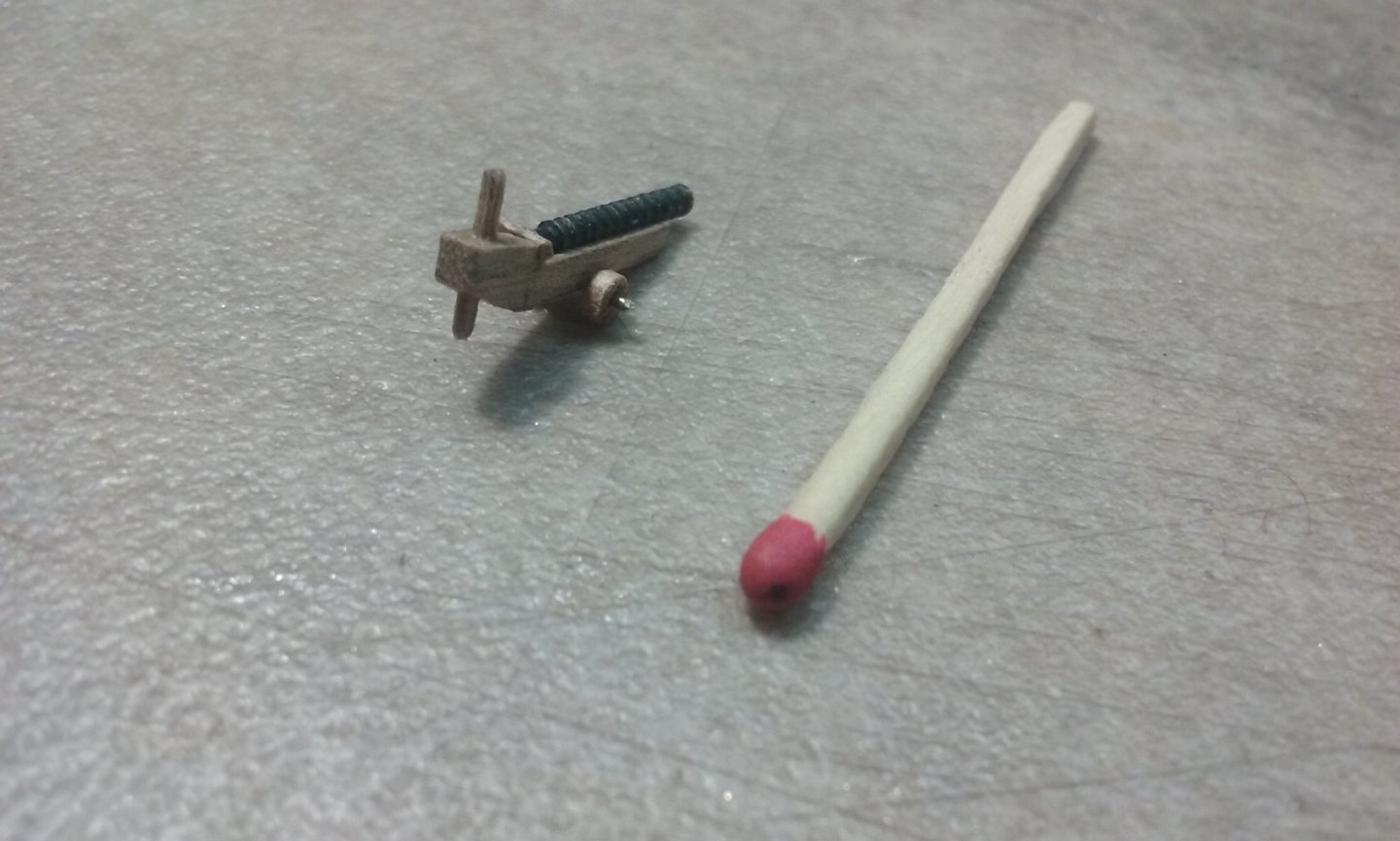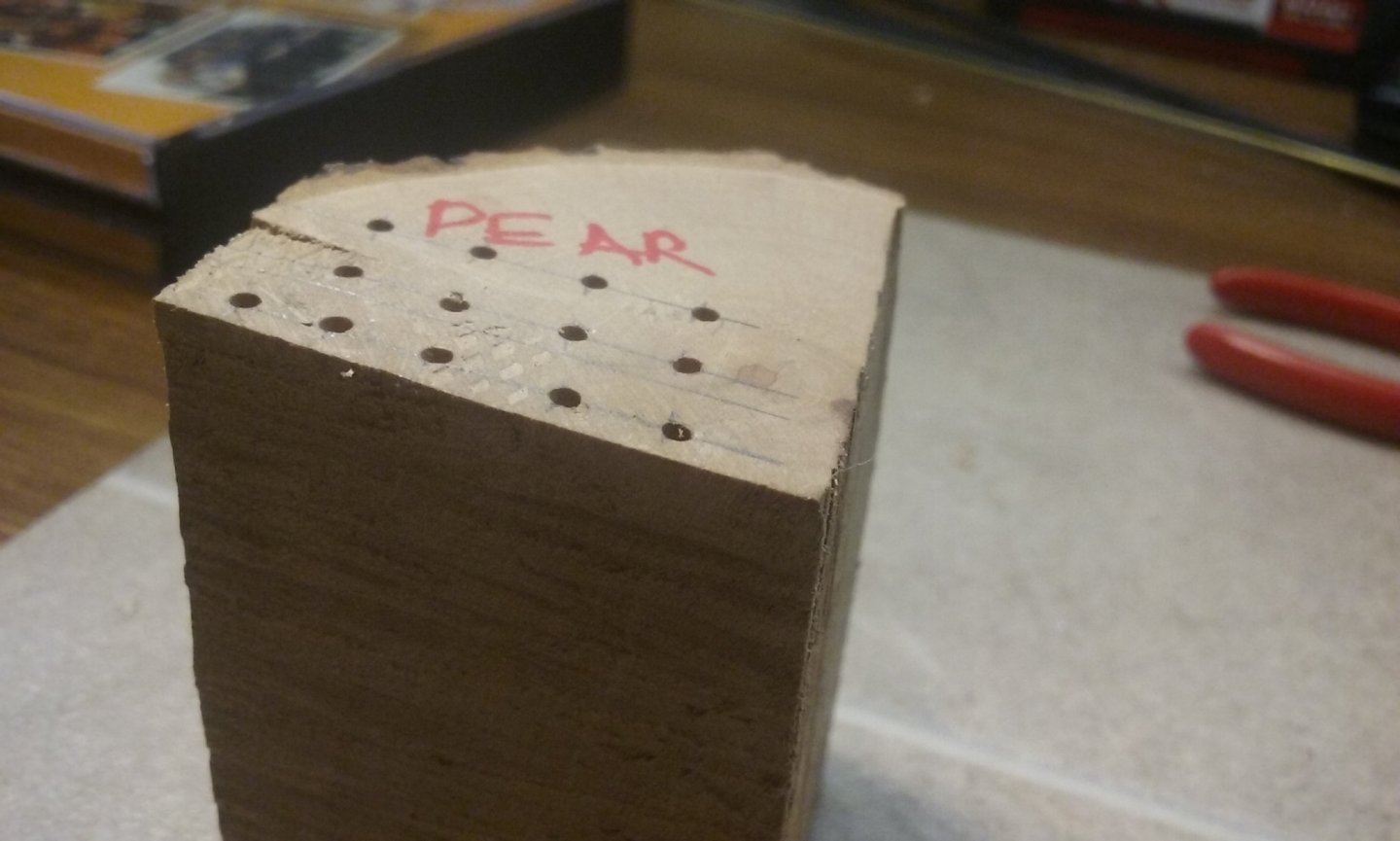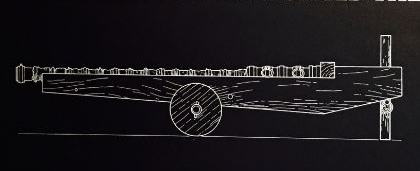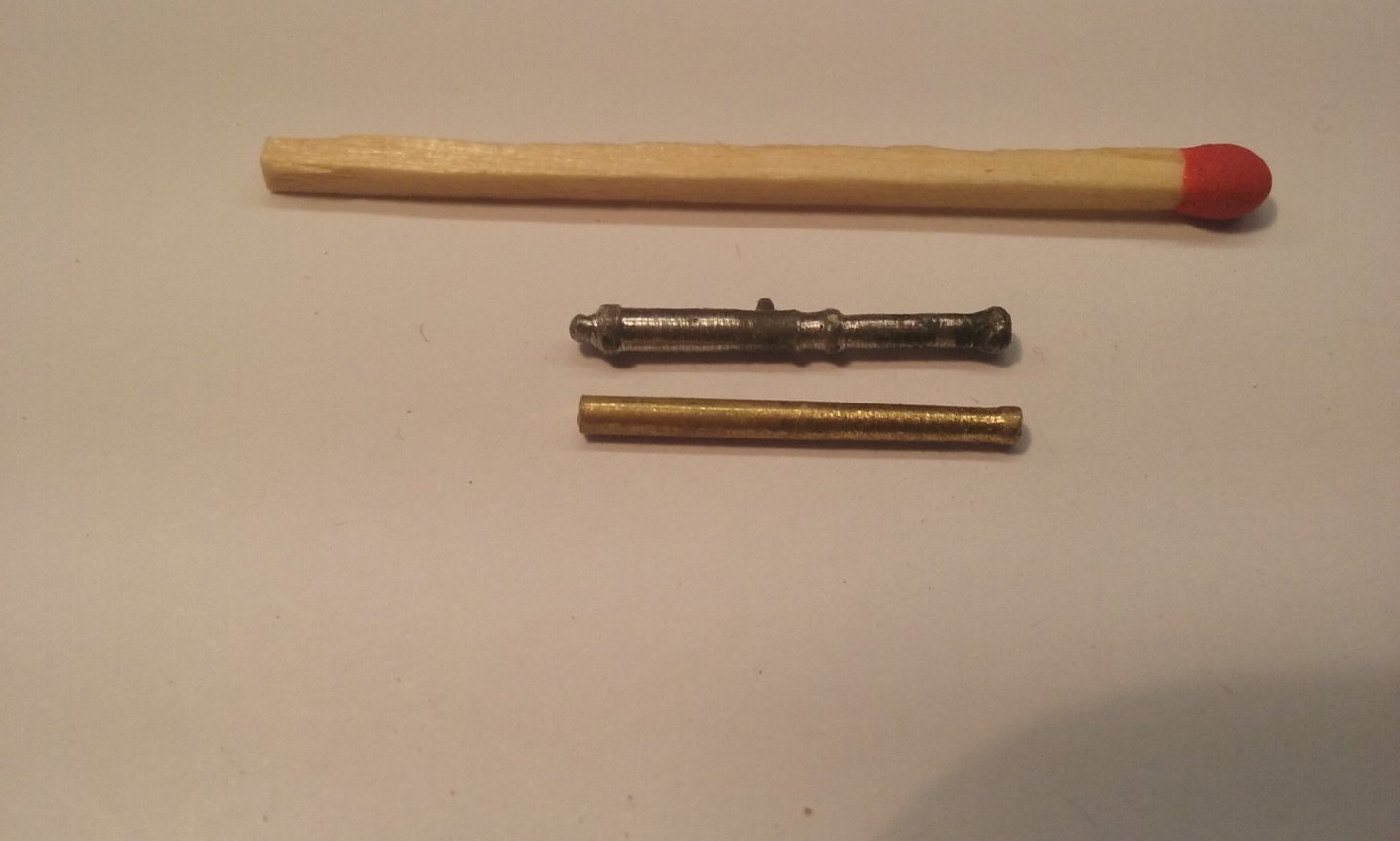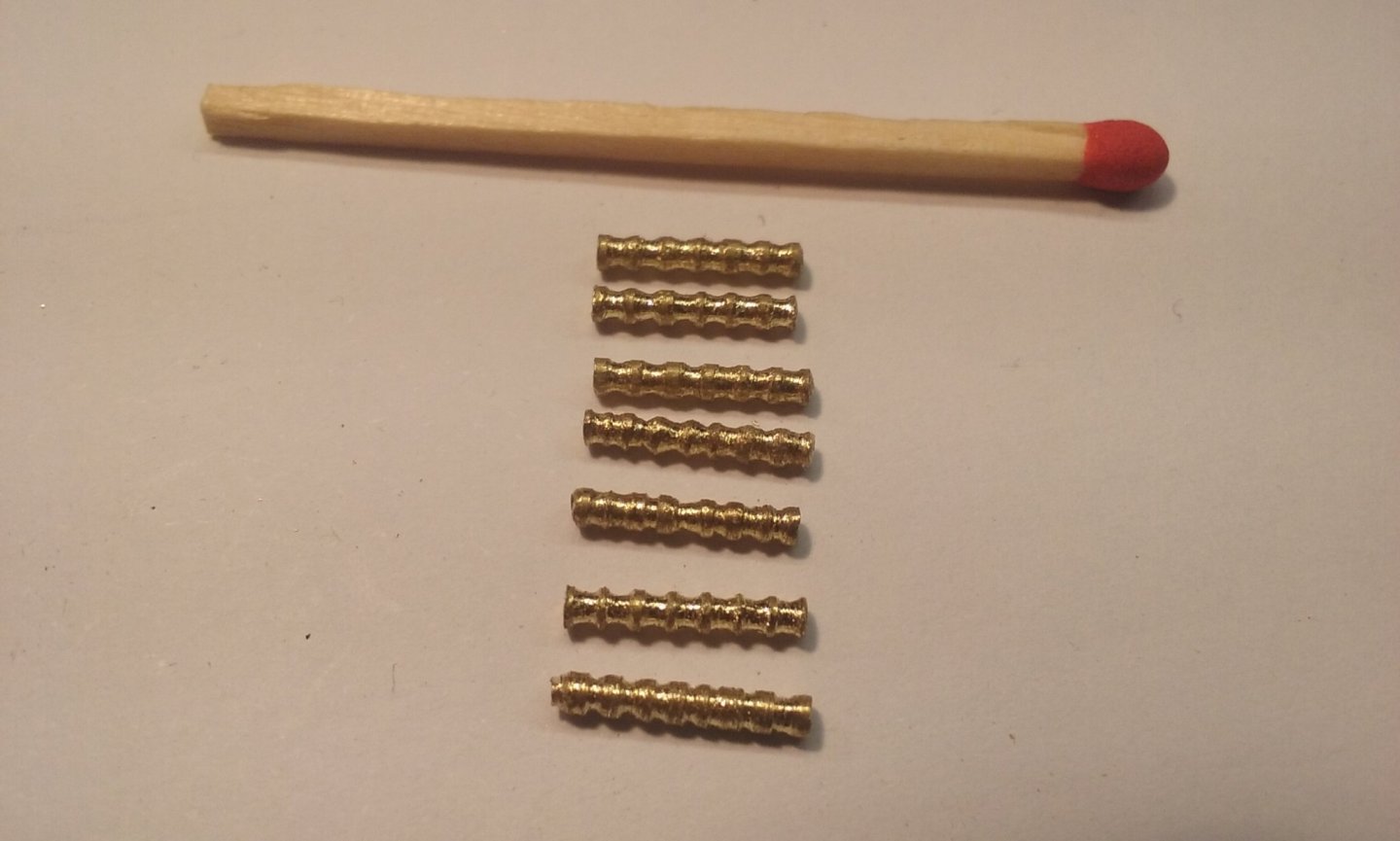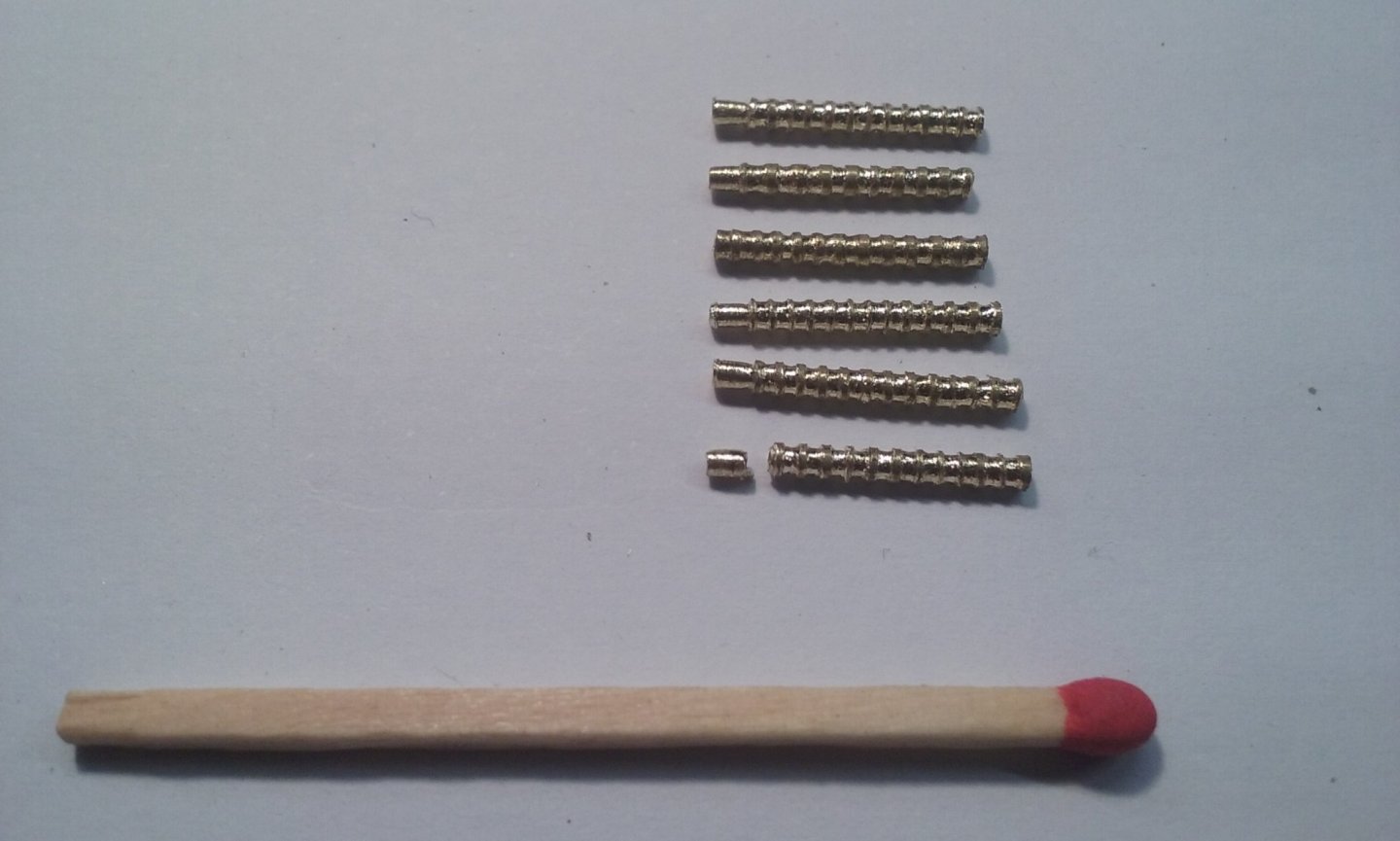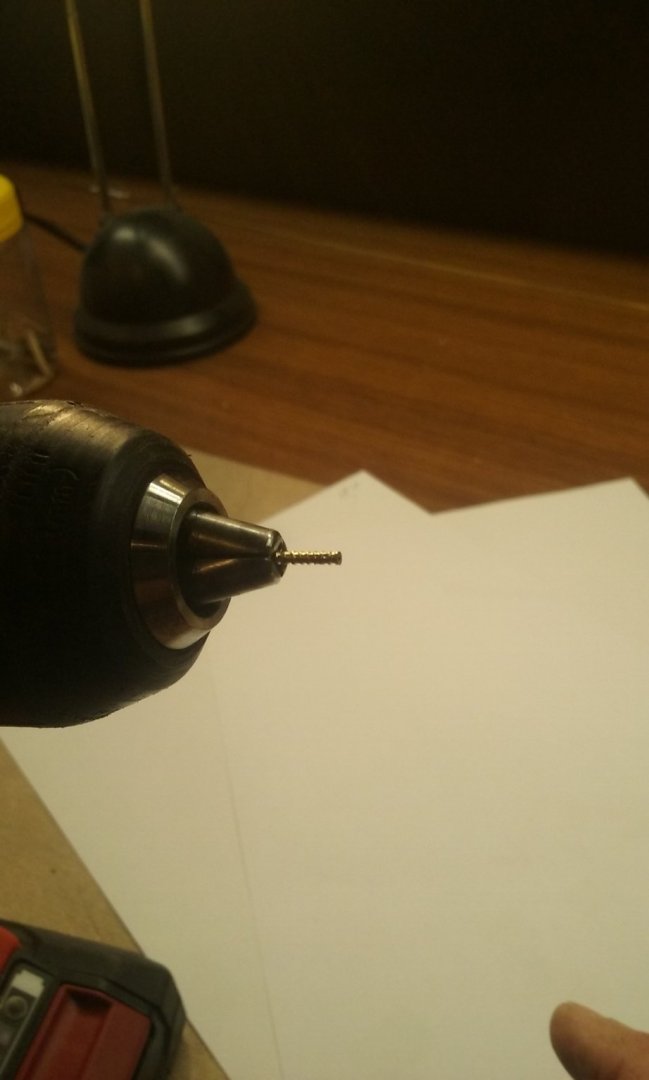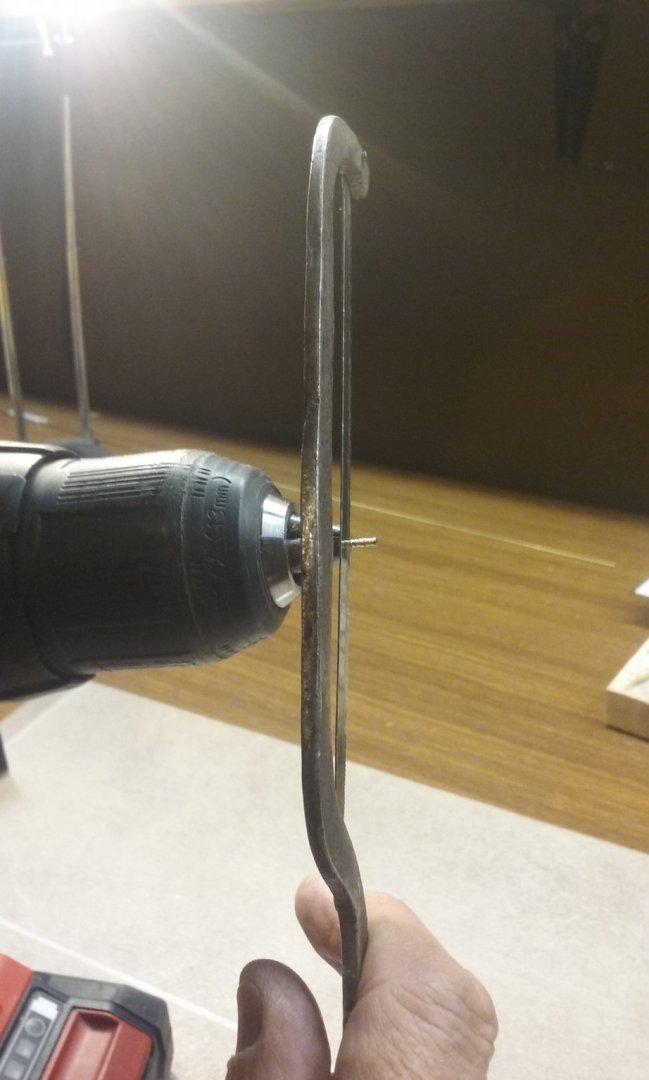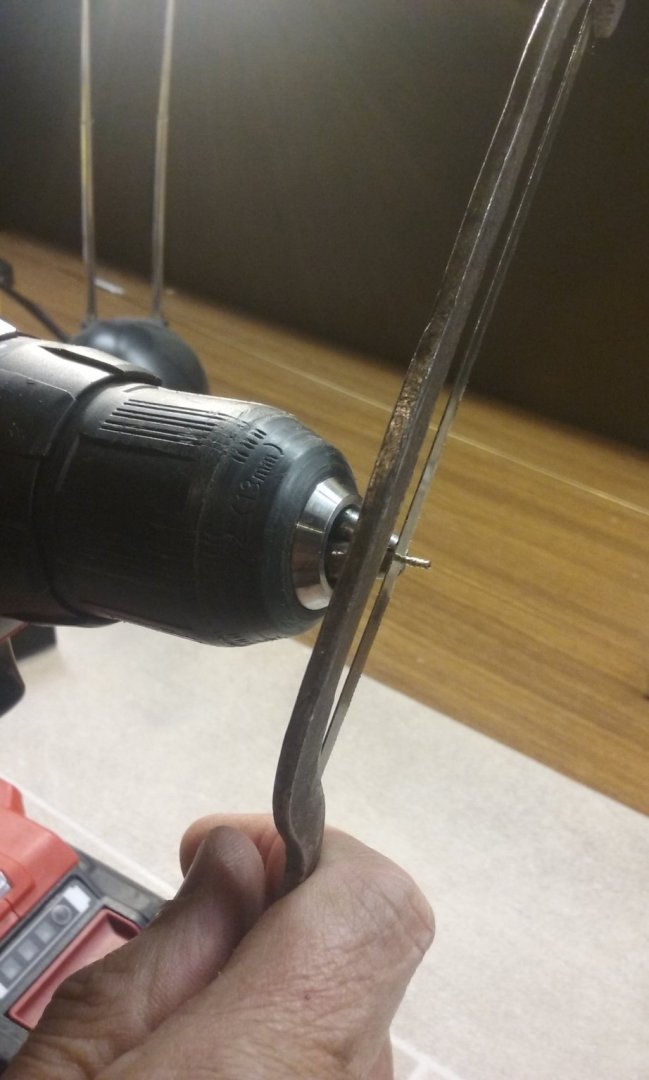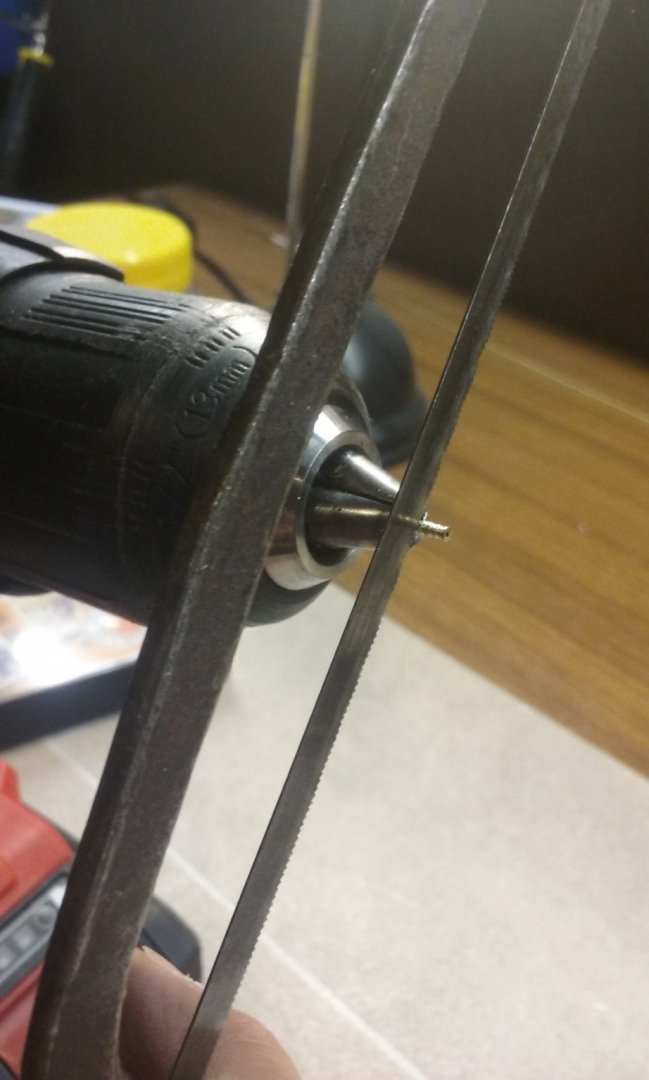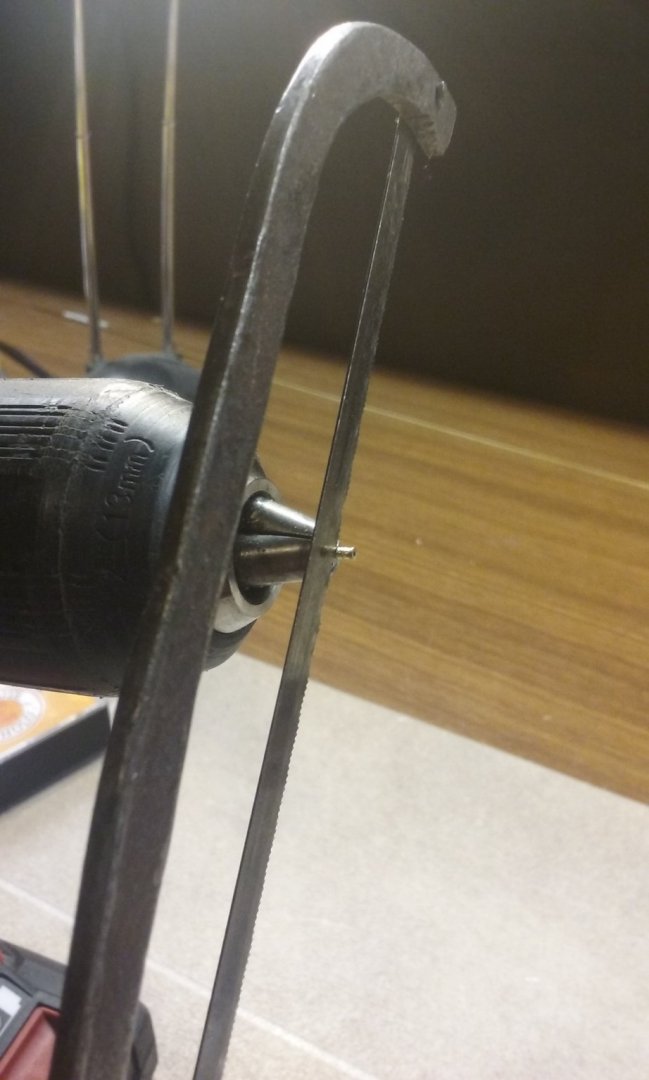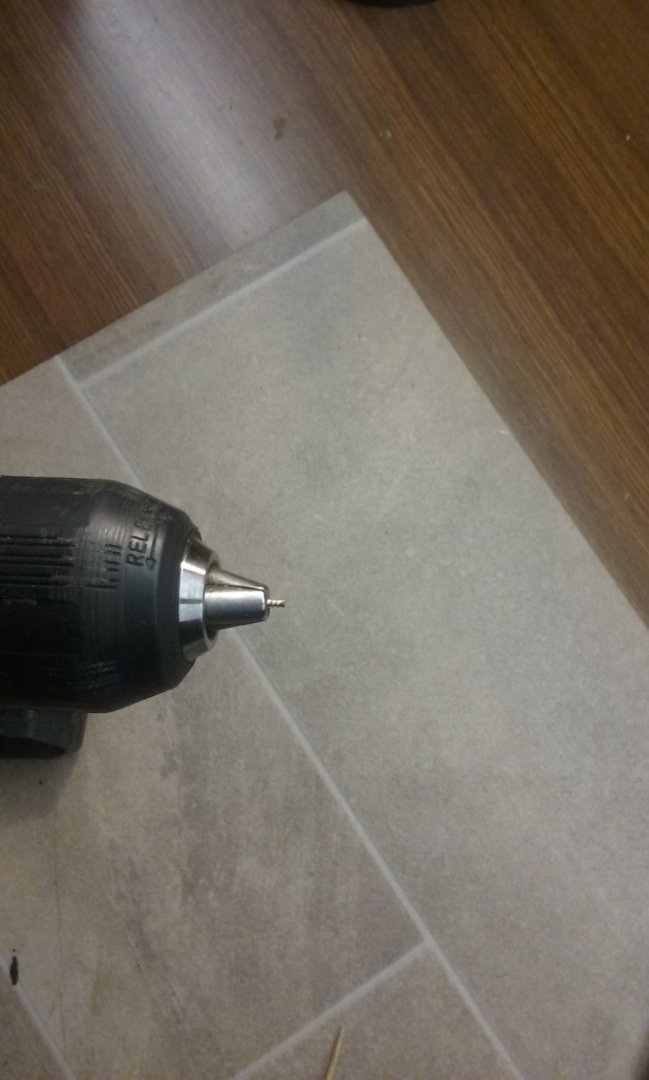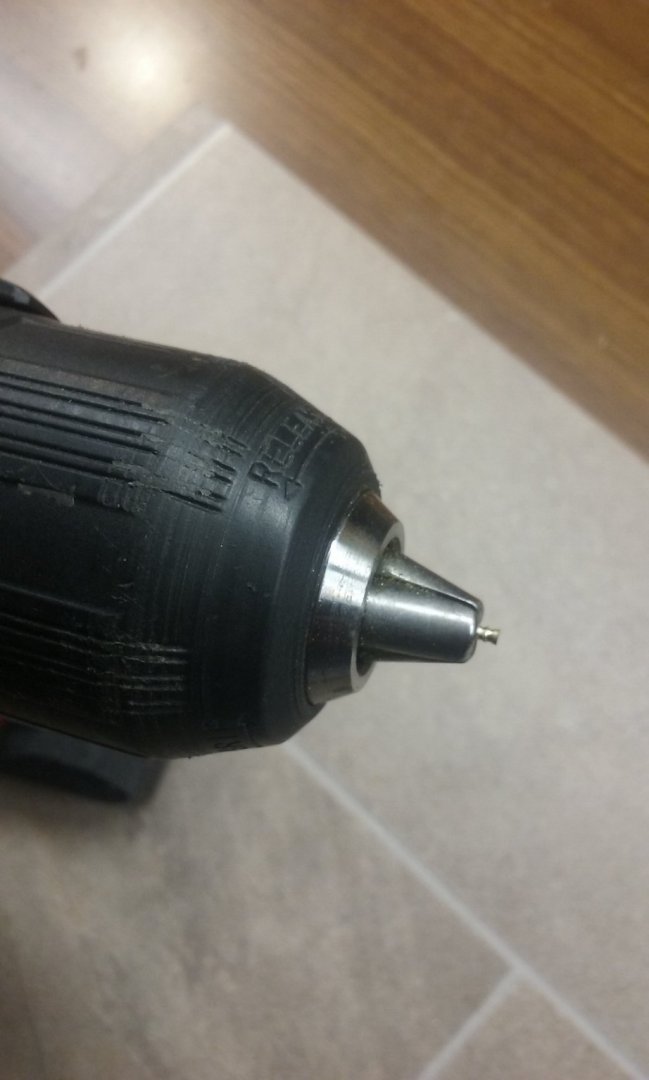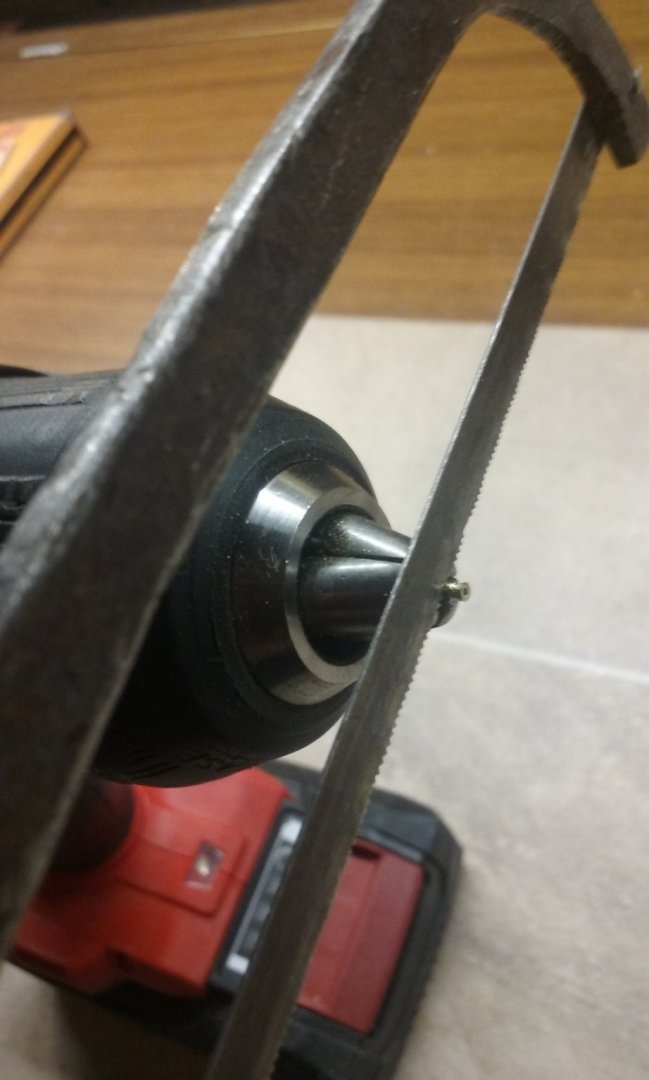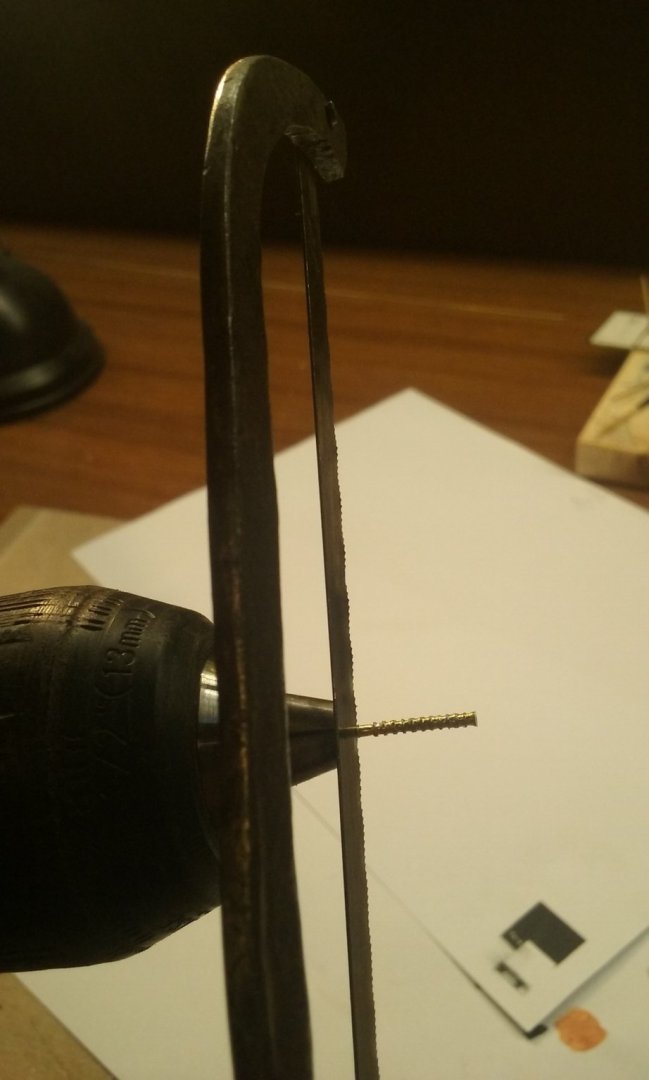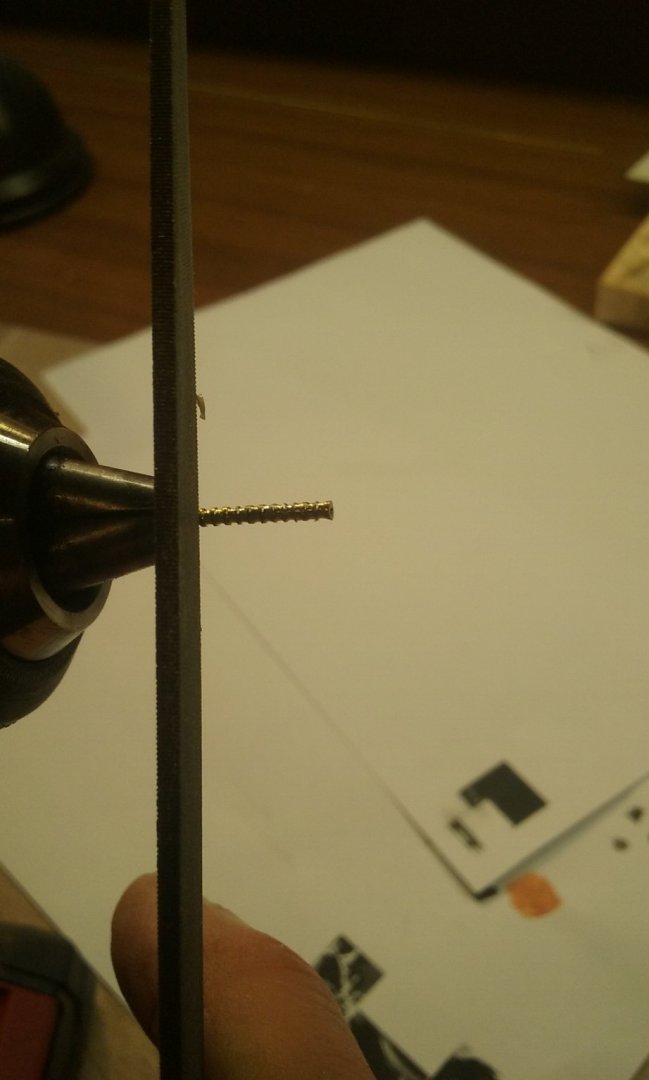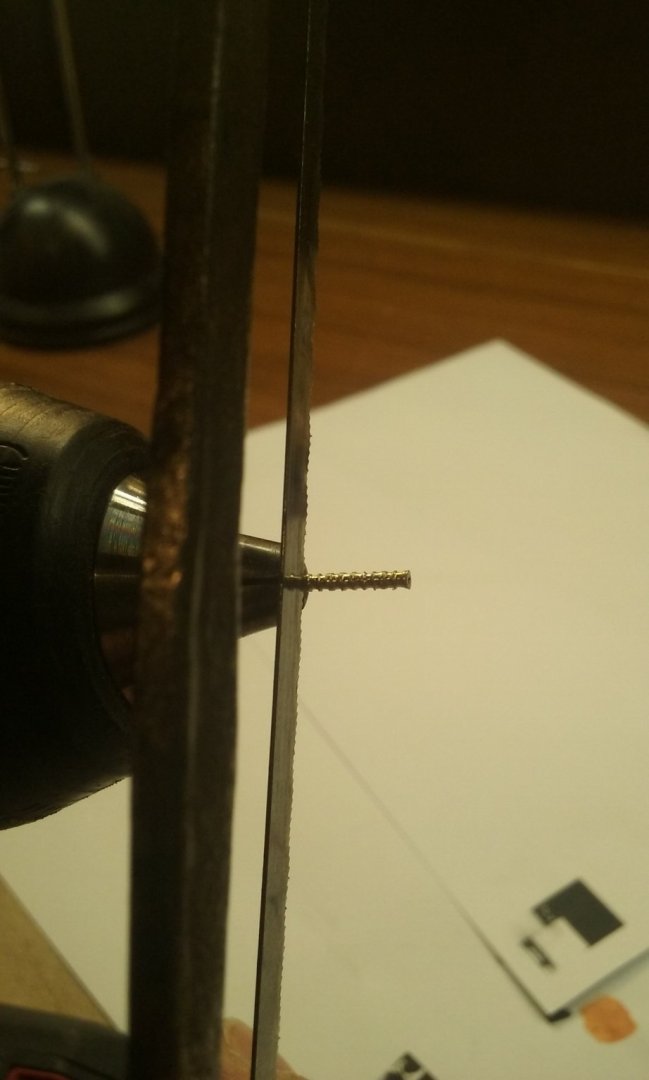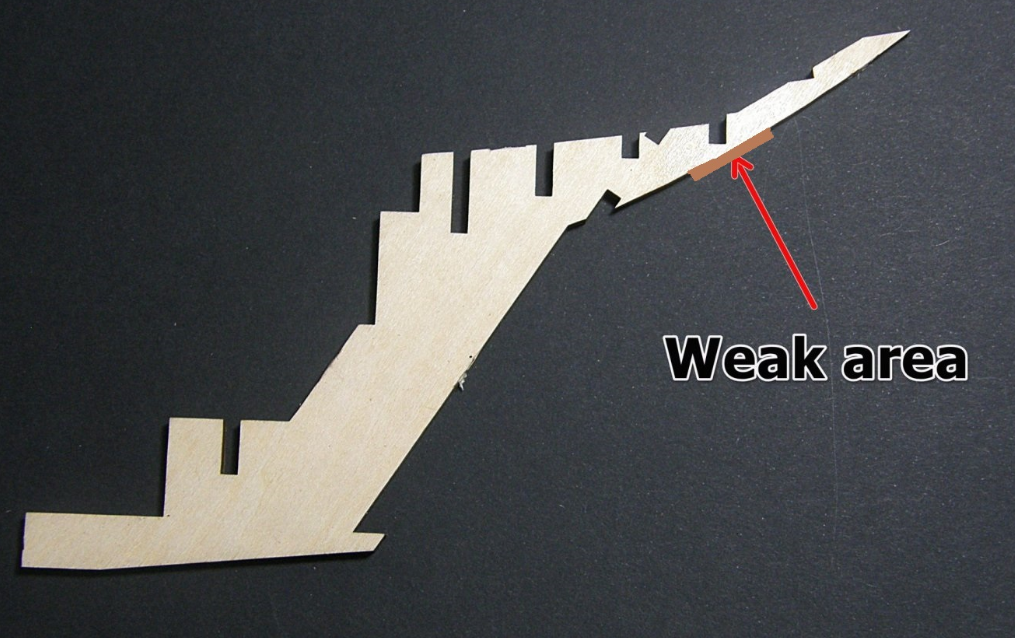-
Posts
7,986 -
Joined
-
Last visited
Content Type
Profiles
Forums
Gallery
Events
Everything posted by Louie da fly
-
I agree with Banyan's interpretation of the "p" and the "r". Looks like "length of the sprit 31.10" (31 ft 10 inches?) Then "(something) of the deck 24" "below 5.3" "(extension?) of head 29.3 +2 = 31.3" "(Head?) 5.3" "New Mark 36.8" "length of the sprit 31.10" Steven
-
Very impressive, Marcus. I'm following this design evolution with great interest. I'm not sure I have the courage to pull apart and rebuild to the degree you're doing it. Steven
- 332 replies
-
- fluit
- abel tasman
-
(and 1 more)
Tagged with:
-
Mass production of built-up cannons. Gun barrels threaded onto a wire and painted black The blanks for the carriages cut apart And trimmed down to make half-round "beds" for the barrels. And separated into individual carriages The third carriage under construction - As they won't be seen anyway, making full carriages was just to satisfy myself that I could do it. So for the rest of them I just made blocks to take the place of full carriages. More to come. Steven
- 740 replies
-
- Tudor
- restoration
-
(and 4 more)
Tagged with:
-
Very true, Götz. On the other hand, to get any sort of recognition at all young researchers are obliged to come up with something different from what has gone before, and the temptation is perhaps there to disagree with the "old masters" for the sake of saying something new - even if it doesn't make a lot of sense. There are certainly a few things about Pryor's book I disagree with, but it is still far and away the best and most comprehensively researched book on dromons in existence. The Yenikapi discoveries coming just as the book went to print made it somewhat out of date as soon as it came out, but taking that into account, just about all my other disagreements are on very minor issues indeed. And as an academic, to add to or disagree with what he's done you would have to really be on top of your material. The reconstruction of the hull itself is not bad (though even then I have my disagreements with it), but apart from that I don't think it adds to our knowledge of dromons. Steven
-
And not just maritime subjects - almost any academic subject attracts people who seem to be more interested in proving their fellows wrong than in achieving anything useful. On the other hand I think the author was genuinely trying to arrive at a workable truth - I just find it hard to accept most of his conclusions. Well, not completely. It's always good to get another viewpoint, even if you don't agree with it. The "demountable castle" concept is attractive, given the huge scarcity (only one known example) of castles in contemporary pictures of dromons. But where would they be stored on-board? And would they be solid enough to fight from? It's an interesting idea and I haven't totally dismissed it, but as I've already built the things (though not fitted them), I expect I'll go ahead with them even though the ship will be displayed with masts and sails. And his reconstruction of the oarbenches is almost identical to what I came up with independently (though I decided not to use a fore-and-aft beam joining the benches, having decided it would interfere with free movement for the oarsmen in times of combat). Also his deck beams (lightweight crossbeams - to allow for limited headroom - supported by two intermediate fore-and-aft beams sitting on columns either side of the lower walkway) is exactly how I'd envisioned them, though I didn't put the support beams and the columns in the model because they weren't structurally necessary at that scale. Not a complete waste of time, but I feel rather a wasted opportunity in many ways - it could have been much better. Steven
-
Well, I’ve had a pretty good look over this new paper (which turns out to have been published in 2010 – who knew?) and though I agree with some of it – the cross-section follows the Yenikapi finds, and makes sense structurally (though if the oars were configured the way they’re drawn they would foul each other and break). The shape of the ship makes sense and is a possible interpretation of the information available from contemporary descriptions and pictures, and from the archaeological record. However, I have quite a few objections to this interpretation. One thing I do have a problem with is his contention that the lower oarbank had one man per oar, but the upper had two. This comes from a contemporary source regarding the number in the crew, and he goes into some detail as to why this would be. This or similar ideas are advanced by other academics, but Pryor interprets the data differently, saying one man per oar in each bank. I don’t follow maths of either argument – there are contradictory numbers in the original sources – but in my view this interpretation violates Occam’s razor – it’s an unnecessarily complex solution to a simple problem. The spur is interpreted as an “assault bridge” even though the spur is mentioned repeatedly in the contemporary sources, while there’s never any mention of an assault bridge. Granted that absence of evidence is not evidence of absence, nonetheless it would be surprising if an assault bridge really existed that it wouldn’t be mentioned in the manuals. It is also proposed that the spur/bridge was fixed permanently to the structure of the ship, and though I find Pryor’s interpretation somewhat lacking – the spur fixed to the hull by what the sources call a “pin” which would make it pivot around the fixing point in event of ramming - this author doesn’t answer the evidence Pryor puts forward, which is quite extensive. Though there is a case for single mast rather than two (I think I’ve covered this earlier in my build log) this paper dismisses Pryor’s arguments for two masts without answering them. It also proposes that the xylokastra (side castles) – and even the pseudopation (forecastle) would foul the lateen sails and therefore would be temporary structures erected only when rowing (masts lowered) into battle. An interesting interpretation but if so why is it never mentioned in the sources? On contrary, the contemporary descriptions suggest that these structures were permanent. Also, many other relatively contemporary pictures of galleys show a forecastle – a fact this paper does not mention. Though I don’t claim to be an expert, much of the time when sailing, a lateen yard is on a very slight angle indeed – almost horizontal – rather than on the sharp angle you often see in modern reconstruction drawings, so it wouldn’t foul the castles. And a dromon could only sail with the wind directly behind it – more than 10 degrees of heel would put the lower oarports under water – so the lower ends of the yards would normally be out to the sides of the ship. Though the paper quotes Pryor extensively, but it seems only to disagree with him. It fails to cover many issues Pryor raises which would, if properly examined, cast doubt on the ideas it advances. It raises a few new concepts, but not many that I believe improve our understanding of dromons. Steven
-
Don't forget to allow for the overlap in the scarph joints! I've found myself having to remake items because I did and they turned out too short. Steven
-
On the contrary, Mark. The available evidence suggests they removed sails, yards and masts before they went into battle, and one battle is quoted as having been lost because they neglected to do so. Steven.
-
Thanks everybody for the likes and comments. Messis, yes the fires are very widespread and destructive, made worse by the shortage of water caused by the current drought. Thank you for your concern. On a more cheerful note, I've just come across a new paper from Germany outlining an updated theoretical (and practical - scaled 1:10) dromon reconstruction at https://www.academia.edu/24592168/Zur_Modellrekonstruktion_einer_Byzantinischen_Dromone_Chelandion_des_10._11._Jahrhunderts_im_Forschungsbereich_Antike_Schiffahrt_RGZM_Mainz?email_work_card=view-paper Unfortunately it's in German, and I'm currently making my way through the hodgepodge version Google Translate has presented me with, trying to make it make sense in English. Once I've done that I'll figure out whether I agree with it. So far I agree with the general shape of the reconstruction, but not with the oar arrangement. He's introduced an interesting idea - that the xylokastra (side castles) and perhaps even the pseudopation (forecastle) were demountable constructions, only put in place when the ship was going into battle. The reason given that they would interfere with the operation of the lateen sails. Interesting, but I'm not so sure he's familiar with how lateen sails work - from seeing video and still photos of them in operation, I'm not so sure the problem really exists. Also, in places where he disagrees with Pryor's book, he often simply dismisses Pryor's conclusions rather than disprove them. So - a bit unsatisfactory, but I'll suspend judgment until I've had the chance to look over his stuff properly. Interesting, though. Steven
-
Thanks Mark and Pat. I'll make sure I get the right kind. I don't think I want the amount of acetone you can get in Bunnings, so it looks like I'll be perusing the health and beauty aisle at Coles . . . Steven
- 740 replies
-
- Tudor
- restoration
-
(and 4 more)
Tagged with:
-
Here is the first attempt at a built-up gun and carriage, based on one found on the Mary Rose in the 19th century: Barrel and carriage (carved from pear wood): Wheels: Wheels on axle, plus elevation mechanism (a vertical wooden beam at the back of the carriage with holes to put a pin into to adjust the elevation). Carriage assembled - note as this is a preliminary version I haven't cut the axle to length. Barrel in place, (with magazine included as part of the barrel), and elevation mechanism cut to length. Axle cut shorter, but will have to be removed and cut to its proper length. It became obvious that I'd put the wheels too far back - the elevation mechanism depends on the weight of the gun resting backwards, so the wheels should be a little forrard of the centre of gravity - and of course otherwise the thing tips forward, as it does here. As I've glued the wheels and axle on with CA I'll need to dissolve it - am I right in thinking nail polish remover works for this? And here is the "blank" for making the rest of the carriages. The holes will be cut in half to make the "beds" for the gun barrels. This is really only for my own satisfaction - the carriages will all be pretty much hidden within the hull - but it's fun doing it. The guy across the road (he drilled the holes with his mighty drill press) thinks I'm nuts. Steven
- 740 replies
-
- Tudor
- restoration
-
(and 4 more)
Tagged with:
-
Kris, the presence of shields on the Oseberg ship i news to me. I'd never heard of that before. A rail for shields is called a pavesade. And yes, the gunwale got that name in the 15th century when the only guns in use were relatively light and were placed on the top wale. As they got heavier, to keep the ship stable they had to be placed lower down but the name continued to be used. Of course I found the same applied to my dromon, from well before the invention of guns - if you don't call it a gunwale, what do you call it? Steven
-
The best and most informative site I know of for Viking shields is http://members.ozemail.com.au/~chrisandpeter/shield/shield.html - Chris and Peter are friends of mine from way back when I was a re-enactor. On the other hand, there were no shields found on the Oseberg ship, so if you don't want to add them . . . Kriswood, interesting about the treenails. I didn't know about that. Steven
-
Unless I'm much mistaken, Viking ships didn't use treenails - they had iron nails "rivetted" over at both ends.
-
And here are the completed barrels. The upper group are the first ones I did. I later discovered I'd got my arithmetic wrong and they should have been longer, as are the ones below. I also didn't add magazines to them, but as only the ends of the barrels will be visible i decided just to forge ahead - any major differences will be hidden within the hull. Note - I inadvertently cut the magazine off one of these, but I figure I can just put it on the carriage behind the barrel and it should be fine. And I've cleaned up the "cast bronze" barrel I made back when I was 17, and I'll be casting a group of them which will be visible in the waist. Plus one I turned on the electric drill for the gunports where only the end of the barrel will be visible. I think it's close enough to pass muster . . . Steven
- 740 replies
-
- Tudor
- restoration
-
(and 4 more)
Tagged with:
-
Here's the sequence I used in making the built-up cannons. Using a bit of 1.5mm brass tube set into my "poor man's lathe" - its main disadvantages are that you have to keep a finger on the start button (yes, I could bypass this but didn't bother) and that there's no support on the other end so bending of the tube is a risk. I overcame the second by sawing right up next to the jaws of the chuck, with just the combined thickness of the sawblade plus the reinforcing ring sticking out. Not so good either for the sawblade or the chuck, but I managed to get away with it. Then slide the tube out of the chuck by the same combined thickness of sawblade and reinforcing strip and do it again: (I forgot to photograph the first cut, so the above is of the second.) Then the same thing again: And again: And again and again: Last ring - full length of the barrel: And then the "magazine", using a file: And cutting the whole assembly to length
- 740 replies
-
- Tudor
- restoration
-
(and 4 more)
Tagged with:
-
Okay, another idea - using PVA, glue a piece of wood to the bottom of this section, as wide as the "sternpost" itself. As I'm not familiar with how the model goes together, I don't know if you can add all 4 strengthening pieces first, but when you no longer need the reinforcing piece dab isopropanol (which you've previously used on Il Leudo) onto the join between the sternpost and the reinforcing bit, and gently remove it. That might just work. Steven
-
I see in your post of November 25 (see photo below) that the upper frames have tenons that fit into slots in the upper planking. Is this based on contemporary representations, or did you do it to add to the strength of the upper part of the hull? I'm enjoying the build very much, by the way. A beautiful piece of work. Also, I'm very glad to see a galleon model with this particular shape of beakhead, which I've never seen in any other model galleon even though there are plenty of contemporary pictures of them. Steven
-
This is amazing work, Dan. Your attention to detail, tracking down every tiny item of such a complex vessel and representing it to scale takes my breath away. You can be justly proud of her. Steven
- 238 replies
-
- leviathan
- troop ship
-
(and 2 more)
Tagged with:
About us
Modelshipworld - Advancing Ship Modeling through Research
SSL Secured
Your security is important for us so this Website is SSL-Secured
NRG Mailing Address
Nautical Research Guild
237 South Lincoln Street
Westmont IL, 60559-1917
Model Ship World ® and the MSW logo are Registered Trademarks, and belong to the Nautical Research Guild (United States Patent and Trademark Office: No. 6,929,264 & No. 6,929,274, registered Dec. 20, 2022)
Helpful Links
About the NRG
If you enjoy building ship models that are historically accurate as well as beautiful, then The Nautical Research Guild (NRG) is just right for you.
The Guild is a non-profit educational organization whose mission is to “Advance Ship Modeling Through Research”. We provide support to our members in their efforts to raise the quality of their model ships.
The Nautical Research Guild has published our world-renowned quarterly magazine, The Nautical Research Journal, since 1955. The pages of the Journal are full of articles by accomplished ship modelers who show you how they create those exquisite details on their models, and by maritime historians who show you the correct details to build. The Journal is available in both print and digital editions. Go to the NRG web site (www.thenrg.org) to download a complimentary digital copy of the Journal. The NRG also publishes plan sets, books and compilations of back issues of the Journal and the former Ships in Scale and Model Ship Builder magazines.




